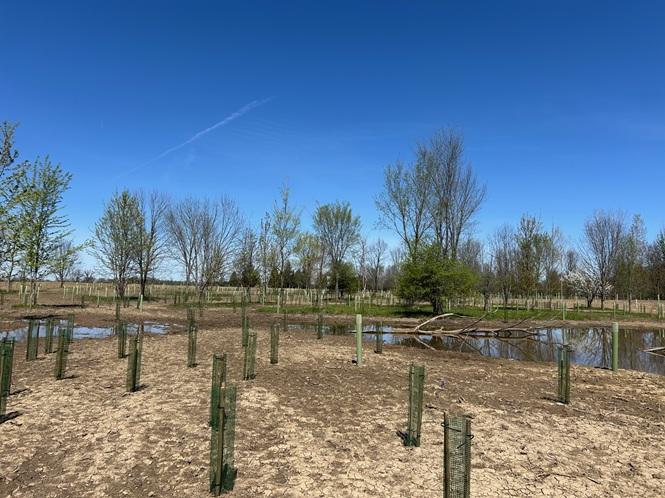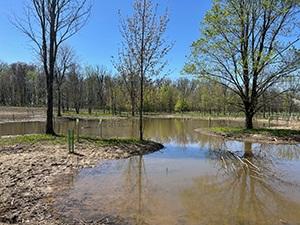
A little more than a mile south of the village of Bascom, just off County Road 7, between U.S. Route 224 and Hopewell-Loudon School, sits the Funk-Dewald Nature Preserve, donated to Heidelberg University nearly 50 years ago by alumnus Wayne Funk, Class of 1921. The preserve has been relatively unchanged since it was donated, with many old-growth oak trees, a large stand of wild spicebush, and has served as a refuge for local wildlife, including white-tailed deer and wild turkeys.
Since the preserve was left reasonably unmanaged for several decades, over time, the open meadow portion of the nature preserve had become overgrown with a lot of invasive plants that were hindering its function as a natural area and its ability to retain water throughout the entirety of the property, said Jake Boehler, Field Manager for Heidelberg’s National Center for Water Quality Research (NCWQR) and Sandusky River Watershed Coalition Coordinator. "It became necessary to restore the property to its historically important role as a wetland complex, and the H2Ohio program provided a great opportunity to make that happen,” he said.
For the better part of a year, the NCWQR has worked with the Ohio Department of Natural Resources’ H2Ohio program and contractor MAD Scientist Associates LLC to restore 16 of the nature preserve’s 47 acres to a wetland.
In collaboration with ODNR, Jake submitted and received an almost $450,000 grant to fund the restoration project through Ohio Gov. Mike DeWine’s H2Ohio Program. H2Ohio is a comprehensive, statewide initiative focused on improving water quality and protecting Ohio’s vital water resources to ensure clean, safe water for future generations.

Heidelberg’s project focused on restoring specific areas of the nature preserve that required improvement to enhance water quality, while intentionally preserving healthy ecosystems, such as the mature old-growth forest that was already functioning effectively.
Creating wetlands where they once existed decades ago is one way to help improve water quality. Jake describes wetlands as “nature’s kidneys,” acting as natural filters that help improve water quality and provide other benefits such as flood protection, erosion control, and habitat for diverse species.
As part of the wetland restoration, several vernal pools are now in place within wooded areas to enhance existing vernal pools. Vernal pools, also known as seasonal pools, are a distinctive type of wetland habitat. These small, shallow, and temporary bodies of water differ from ponds or lakes in that they lack permanent inlets or outlets. They fill each spring with rainwater and melting snow, then typically dry out during the summer months.
With the wetland construction nearly complete, the next steps are underway to utilize it for environmental and societal benefits, as well as for research and scientific exploration, primarily by the Heidelberg community.
NCWQR researchers will begin monitoring the wetlands, looking for several outcomes such as how insects populate the newly created wetlands and surveying for plant and animal diversity, as well as assessing the effectiveness of the wetland in removing excess nutrients like nitrogen and phosphorus entering the property as runoff from surrounding agricultural fields. Students studying the natural sciences will have opportunities to utilize the land for research by taking part in NCWQR staff research projects, conducting individual research projects, and visiting the property as part of classes to learn about wetlands.
In addition, new trails on the property will make it more accessible for those doing research and open the possibility for collaborations with public entities in the future, Jake said.
“Returning this property to a more natural state will have lasting benefits for years to come for local ecology, water quality, and the Heidelberg community,” Jake said.
About H2Ohio
H2Ohio was initiated in 2019 by DeWine. H2Ohio uses a comprehensive approach guided by science and data to reduce algal blooms, stop pollution, and improve access to clean drinking water.
Collaboration and partnership are important to the success of the H2Ohio initiative. The Ohio Department of Agriculture, the Ohio Department of Natural Resources, the Ohio Environmental Protection Agency, and the Ohio Lake Erie Commission each have a significant role to play by supporting best farming practices, road salt runoff reduction, litter cleanup, dam removal, land conservation, and water infrastructure revitalization.